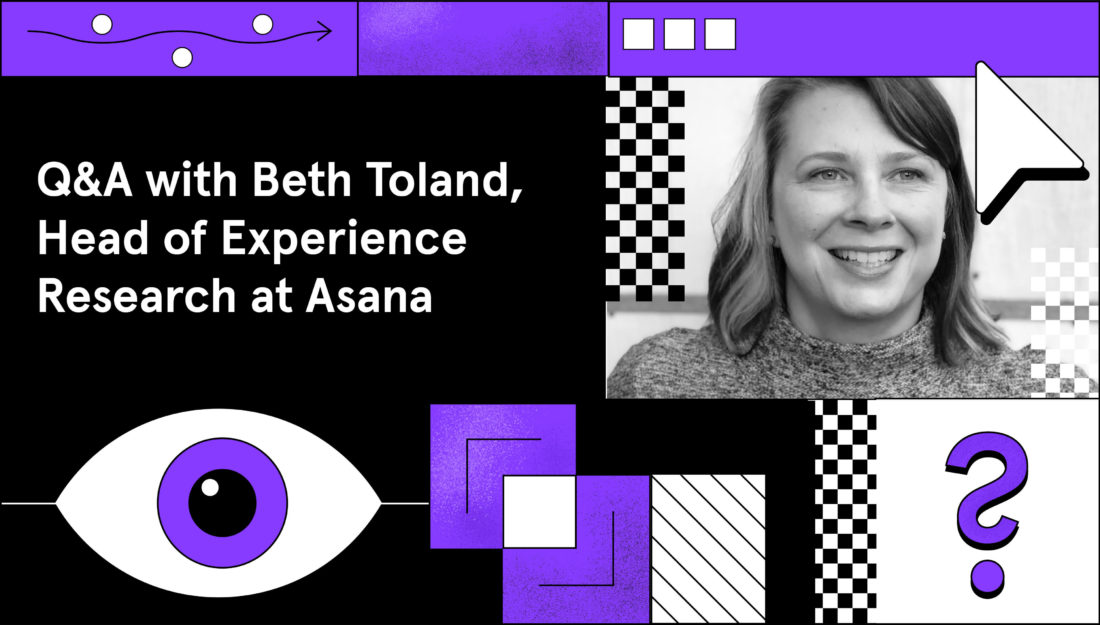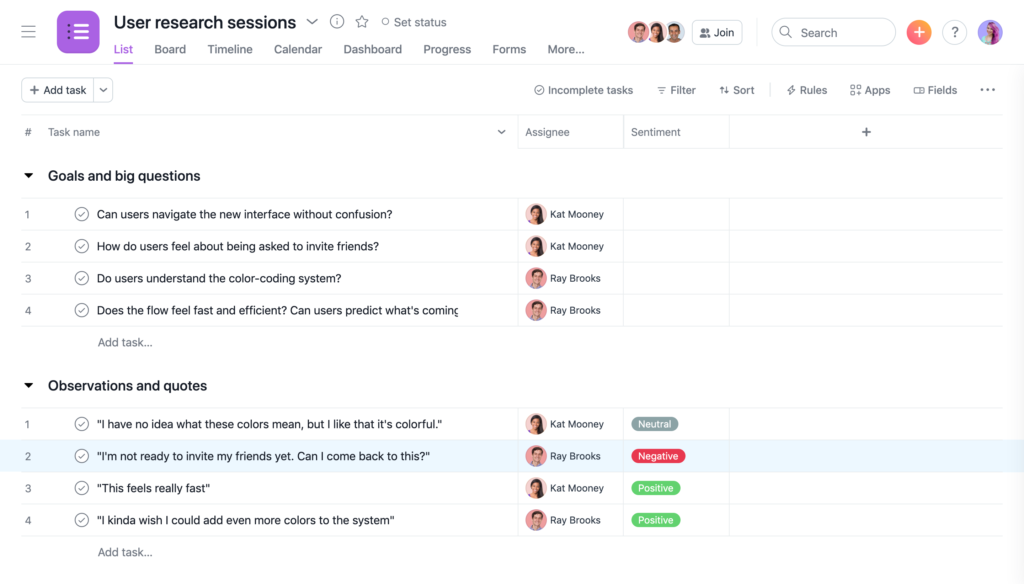
Beth Toland Q&A: Product teams and strategy
In August, one of our favorite innovators, Beth Toland, Asana’s Head of Experience Research joined us for an exclusive live AMA (Ask Me Anything) on building great experiences through understanding. Having received far more questions than she could answer in a single session, Beth is back by popular demand to share her expertise on collaborating closely with product teams and how experience research can influence and advance product strategy.
How do you organize and store research data for future product planning?
Not surprisingly, we use Asana. Within Asana, we have a Project called UXR Findings Library where we organize findings as Tasks by topics, such as Communications, Core Views, Team & Org Dynamics, etc.
In order to make sure that everything is easily findable, we attach searchable, sortable metadata related to the work, including when it was done, which product area it serves, which audience segment it’s useful for, and which team member led the research. Since people usually know at least one or more of those pieces of info, they’re able to find the work they’re looking for pretty easily.
Can you give an example of a case where your research findings have changed product focus or strategy?
In Asana’s early days, we thought about our customer-base in two broad categories: “Champions” and “Everyone Else.” In order to get a more nuanced understanding of our customer, we conducted behavioral segmentation. Fast forward to today, when we have a much deeper understanding of our customers, including how individual segments work together as a team to do great work and to be successful with Asana. In other words, it’s not just about the Champion—it truly does take a team.
What is your process for sharing structured insights from user research with product partners?
As a ground rule, we involve our Product and Business stakeholders in the research process from the beginning; data collection to synthesis, even socialization of the findings.
In terms of getting the broader team involved, I recommend conducting research debriefs to share insights along the way; you’ll not only learn where their interests and biases lie, but you’ll also deepen your work by incorporating their perspective and expertise into the conversation.
To address the “structured insights” issue specifically, when a project is complete, we might set up a “roadshow,” which is a more formal presentation of our work tailored to a specific audience (e.g., schedule time to present at a Marketing team all-hands or take over a Design team meeting to workshop UXR insights in a way that is customized for them). One very important audience we address with our bigger, more foundational work is Asana’s Product Forum, which is attended by our Head of Product, Head of Engineering, and Head of Product Marketing. When the research process is complete, we distribute insights to the right group via Asana and add it to our UXR – Findings project in Asana for future reference.

Here’s a sample usability testing template in Asana that can be used to share insights with product managers or designers. Learn more here.
How do you ensure your research has a long-lived, sustained impact?
Building a company culture that is dedicated to creating consistently delightful experiences within the product is key to driving research that supports the entire organization. At the same time, there are also steps you can take to ensure that your research has a lasting impact. First, make sure your findings are actionable, include a “so-what,” and business impact. Simply put, it’s hard to ignore a finding that explains why you are hemorrhaging customers.
Second, create an accountability system. You can do this by assigning an owner to each finding. You can also ask that OKRs (objectives and key results) be established in relation to particular research initiatives. For example, you could commit to resolving x% of P0 issues submitted by UXR in Q2, or include two UXR insights in your upcoming roadmap. Additionally, you can publish a regular list that highlights key findings and customer pain points that remain unresolved. I also recommend publicly celebrating the folks who solve customer pains you’ve identified. For example, we like to add a note to a team or company newsletter or request a shout-out at an all-hands meeting.
Finally, you can host a monthly meeting to share key insights with Product, Design, Engineering, and customer-facing teams to give them a chance to ask questions about insights, while adding more accountability to your work. At the next meeting, your audience will be on the lookout to see which issues have been solved.
How do you find the elusive balance of quantitative and qualitative UX insights to influence product decisions?
The “balance” is whatever makes sense for the project, but I think qualitative and quantitative almost always complement one another. Work with your partners in each discipline at the very start of the project to see what the possibilities are. Also, don’t limit yourself to data science or site behavioral data—there are other ways to add dimension to your work such as customer tickets, call and chat logs, churn, and sign-up data.
Want to hear more insights from Beth? Check out her AMA on building great experiences through understanding.






